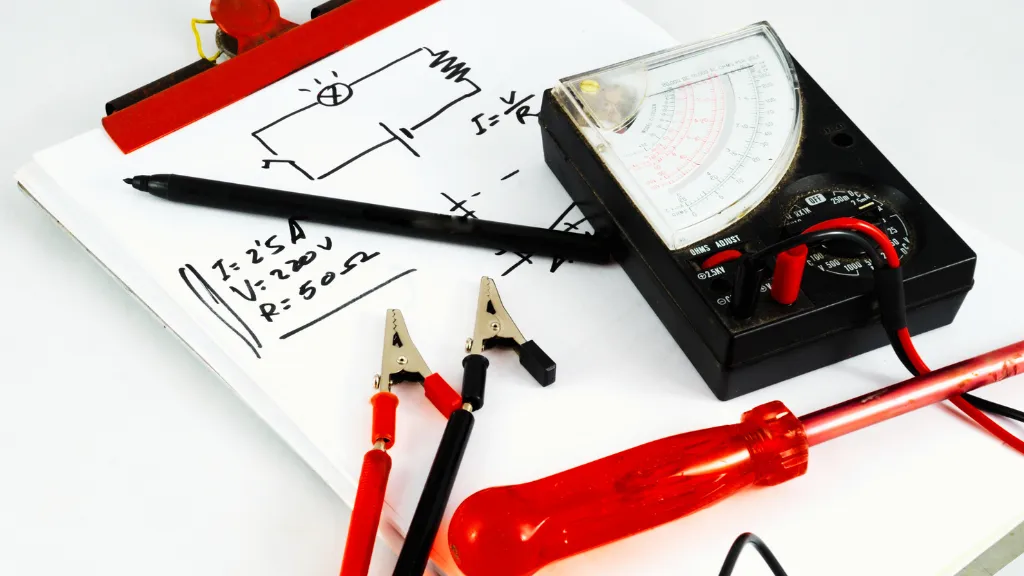What is Ohm’s Law? | A Comprehensive Guide
Ohm’s Law is a fundamental principle in electrical engineering and physics that describes the relationship between voltage, current, and resistance in an electrical circuit. This law is for those working directly with electronics and anyone interested in understanding how electrical devices operate.
In this comprehensive guide, we’ll explore what Ohm’s Law is, its formula, applications, and some frequently asked questions to deepen your understanding of this essential principle.
What is Ohm’s Law?
Ohm’s Law is a foundational principle in electrical engineering and physics. It elucidates the relationship between an electrical circuit’s voltage, current, and resistance.
This principle asserts that the electric current passing through a conductor from one point to another is directly proportional to the voltage between those two points. Formulated by the German physicist Georg Simon Ohm in 1827, it has become a pivotal concept for those studying or working within electrical and electronic domains.
Understanding Ohm’s Law requires familiarity with its three primary components: voltage (V), current (I), and resistance (R). Voltage, or electric potential difference, is the driving force that propels electrons through a conductor.
It’s analogous to the pressure pushing water through a pipe. Measured in volts (V), voltage is the energy per unit charge.
On the other hand, current represents the rate at which electric charges flow through a conductor, measured in amperes (A). Imagine it as the flow rate of water through the pipe.
Resistance, measured in ohms (Ω), signifies the material’s opposition to the flow of electric current—similar to how the pipe’s width and roughness affect water flow.

The Formula of Ohm’s Law
Voltage (V)
Voltage, also known as electric potential difference, is the force that drives electric current through a conductor. It is measured in volts (V).
Current (I)
Current is the rate at which charge is flowing through a conductor. It is measured in amperes (A).
Resistance (R)
Resistance is a measure of the opposition to the current flow in an electrical circuit. It is measured in ohms (Ω).
The formula of Ohm’s Law is elegantly simple:
V = I x R
This formula means that the voltage (V) across a conductor is equal to the current (I) flowing through it multiplied by the conductor’s resistance (R).
Applications of Ohm’s Law
Ohm’s Law, with its fundamental relationship between voltage, current, and resistance, is the bedrock for numerous practical applications in the electrical and electronics fields. Its utility spans from designing intricate electronic circuits to ensuring the functionality and safety of electrical appliances.
Below, we delve deeper into the myriad applications of Ohm’s Law, showcasing its versatility and critical role in the modern world.
Design and Analysis of Electrical Circuits
Ohm’s Law is instrumental in the design phase of electrical circuits. Engineers and circuit designers rely on it to determine the specifications of components needed to achieve desired performance.
For instance, using Ohm’s Law, one can calculate the correct resistance value required to limit the current flow through an LED, preventing it from burning out. Similarly, in more complex circuits, such as amplifiers or power supplies, Ohm’s Law helps determine the values of resistors, capacitors, and inductors to ensure optimal performance.
Electrical Safety Measures
The principles of Ohm’s Law are crucial for ensuring electrical safety in residential and industrial settings. They aid in the selection of appropriate wire sizes to prevent overheating and potential fires.
Electricians use Ohm’s Law to calculate the maximum current that wires and electrical equipment can safely handle, ensuring that fuses and circuit breakers are rated correctly to protect against overcurrent conditions.
Power Calculation and Energy Efficiency
Ohm’s Law is directly linked to calculating electrical power, a function of voltage and current (P = V × I). Understanding this relationship is vital for assessing the energy efficiency of devices and systems.
Engineers use Ohm’s Law to optimize the power consumption of electrical devices, from household appliances to industrial machinery, ensuring they operate within their most efficient range. This optimization saves energy and reduces operational costs and environmental impact.
Troubleshooting and Maintenance
Ohm’s Law provides a systematic approach to diagnosing issues when troubleshooting electrical and electronic circuits. Technicians can identify components not operating within their expected parameters by measuring voltage, current, and resistance.
This could involve locating a resistor that has changed value due to age or thermal stress or finding a short circuit allowing excessive current to flow. Ohm’s Law serves as a detective’s tool in the electrical world, quickly identifying and rectifying faults.
Educational Tool for Fundamental Concepts
Ohm’s Law is often one of the first principles taught in physics and electronics courses, serving as a gateway to more complex topics. It provides a practical context for understanding the behavior of electrical circuits, making abstract concepts more tangible.
Through experiments that illustrate Ohm’s Law, students gain hands-on experience with electrical measurements, enhancing their comprehension of electrical phenomena and laying a solid foundation for advanced study.
Battery and Power Supply Design
Ohm’s Law is pivotal for determining the required specifications to match the load in batteries and power supplies. Designers calculate the expected current draw of a device to ensure that the power source can deliver sufficient voltage at the required current level for optimal operation.
This is crucial in portable electronics, where battery life and efficiency are paramount.

Automotive Electrical Systems
Modern vehicles are replete with electronic systems, from ignition to electric power steering, all of which depend on the principles of Ohm’s Law. Automotive engineers use these principles to design circuits that control various functions, ensuring they operate reliably under varying conditions.
Ohm’s Law is also key in diagnosing electrical problems, from starter motor issues to malfunctioning sensors.
Can Ohm’s Law Help Determine the Power Consumption of an Electrical Device?
Yes, Ohm’s Law can be instrumental in calculating the power consumption of an electrical device. Power in an electrical circuit is the rate at which electrical energy is converted into another form of energy, such as heat, light, or mechanical energy. It’s measured in watts (W).
The power an electrical device consumes can be directly related to voltage, current, and resistance governed by Ohm’s Law.
The formula for power (P) in terms of Ohm’s Law is given by:
P = V x I
This equation indicates that the power a device consumes is equal to the voltage across it multiplied by the current flowing through it. Using Ohm’s Law, we can rewrite this equation in terms of resistance:
P = I^2 x R
or in terms of voltage as:
P = V^2 / R
These formulas are particularly useful when you know two of the three variables (voltage, current, resistance) and need to calculate power consumption. For example, if you know the voltage across a device and its resistance, you can use the second power formula to determine how much power it uses.
This is critical in electrical engineering for designing circuits with appropriate power ratings to avoid overheating and ensure device energy efficiency.
How Can You Use a Multimeter to Verify Ohm’s Law in a Simple Circuit?
Using a multimeter to verify Ohm’s Law in a simple circuit is a practical way to understand the law’s application and to see the relationship between voltage, current, and resistance firsthand. Here’s how you can do it:
- Gather Your Materials: You’ll need a resistor with a known resistance value, a power source (such as a battery), wires to connect the components, and a multimeter capable of measuring voltage, current, and resistance.
- Set Up the Circuit: Connect the resistor to the battery to form a simple circuit. Ensure the connections are secure to prevent any measurement errors.
- Measure the Resistance: Before connecting your circuit to the power source, use the multimeter to measure the resistance of the resistor. Set your multimeter to the resistance (Ω) setting and connect the probes to either end of the resistor. The value displayed should be close to the resistor’s rated resistance.
- Measure the Voltage: Connect the circuit to the power source. Then, the multimeter is set to measure voltage (V), and the probes are connected across the resistor (one probe is on each side of the resistor). This measures the voltage drop across the resistor.
- Measure the Current: To measure the current, you’ll need to alter your circuit so that the multimeter can measure its current flow. Break the circuit at any point and connect the multimeter in series (inline) with the circuit. Set the multimeter to measure current (A) and note the value.
- Apply Ohm’s Law: Use the formula V = I x R to calculate the expected voltage drop across the resistor based on the current measurement and the resistor’s known resistance. Compare this calculated voltage to the voltage you measured directly. The values should be very close, confirming Ohm’s Law.
Can Ohm’s Law be Applied to Non-linear Devices?
Ohm’s Law, in its traditional form, is specifically tailored for linear devices, where the relationship between voltage, current, and resistance remains constant. On the other hand, non-linear devices do not exhibit a straight-line relationship between current and voltage, meaning their resistance can change depending on the applied voltage or environmental conditions.
For non-linear devices, Ohm’s Law doesn’t apply directly because these devices do not have a constant resistance. In the case of a diode, for instance, the relationship between current and voltage follows an exponential curve rather than a straight line, and the “resistance” can vary significantly over different operating points.
However, for small changes in voltage and current, the concept of “dynamic” or “differential” resistance can be somewhat akin to Ohm’s Law. This involves calculating the resistance at a specific point on the curve (the slope of the curve at that point), which allows for the analysis of circuit behavior around that operating point using Ohm’s Law as an approximation.
This approach is particularly useful in analyzing semiconductor devices in electronic circuits.
Conclusion
Ohm’s Law is a cornerstone of electrical engineering, offering a simple yet powerful way to understand the relationship between voltage, current, and resistance. By Mastering Ohm’s Law, students, engineers, and hobbyists can better design, analyze, and troubleshoot electrical circuits.
Whether you’re designing a complex electronic system or simply curious about how electrical devices work, Ohm’s Law provides essential insights into the behavior of electrical circuits.
Frequently Asked Questions
What Happens If the Temperature Changes?
Ohm’s Law assumes that the temperature remains constant. If the temperature changes, the conductor’s resistance might also change, affecting the current.
Can Ohm’s Law Be Applied to All Materials?
Ohm’s Law applies to many materials but not all. Materials that follow Ohm’s Law are called ohmic materials. Non-ohmic materials like diodes do not have a linear relationship between voltage and current.
Is Ohm’s Law Used in AC Circuits?
Ohm’s Law can be applied to AC circuits, but the calculations become more complex due to capacitive and inductive elements that cause phase shifts between voltage and current.

Author
Alex Klein is an electrical engineer with more than 15 years of expertise. He hosts the Electro University YouTube channel, which has thousands of subscribers.
